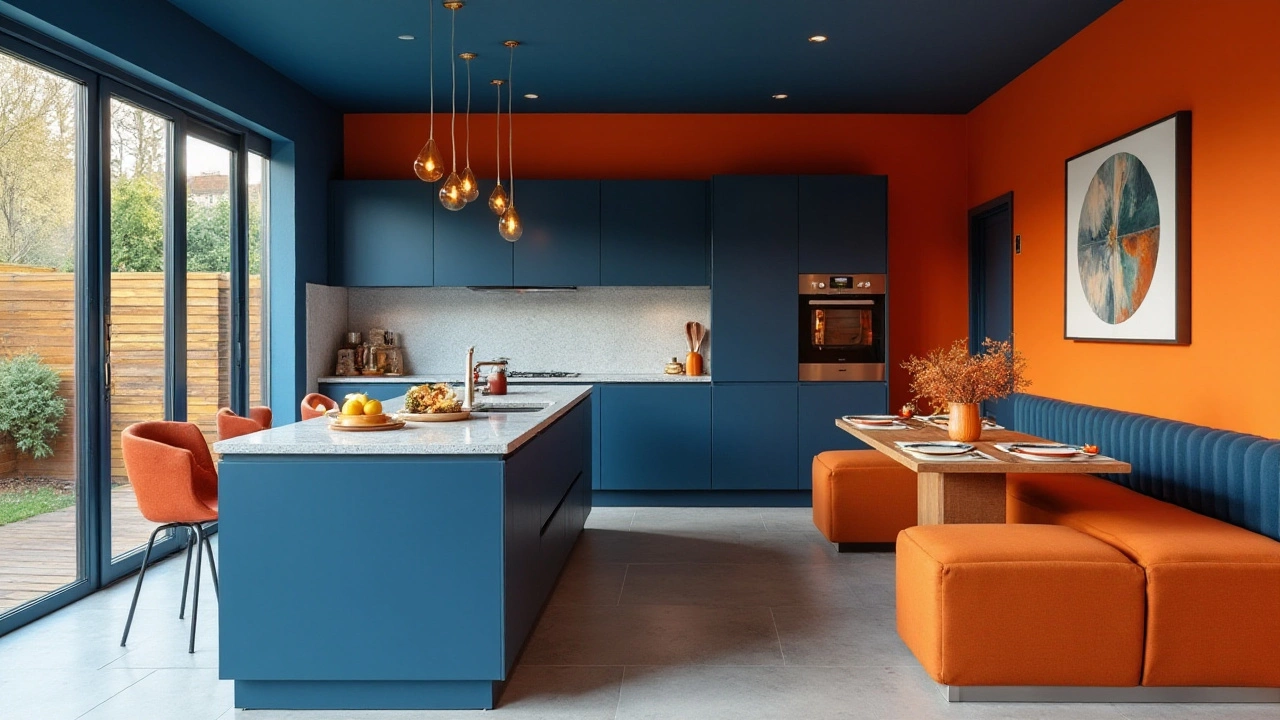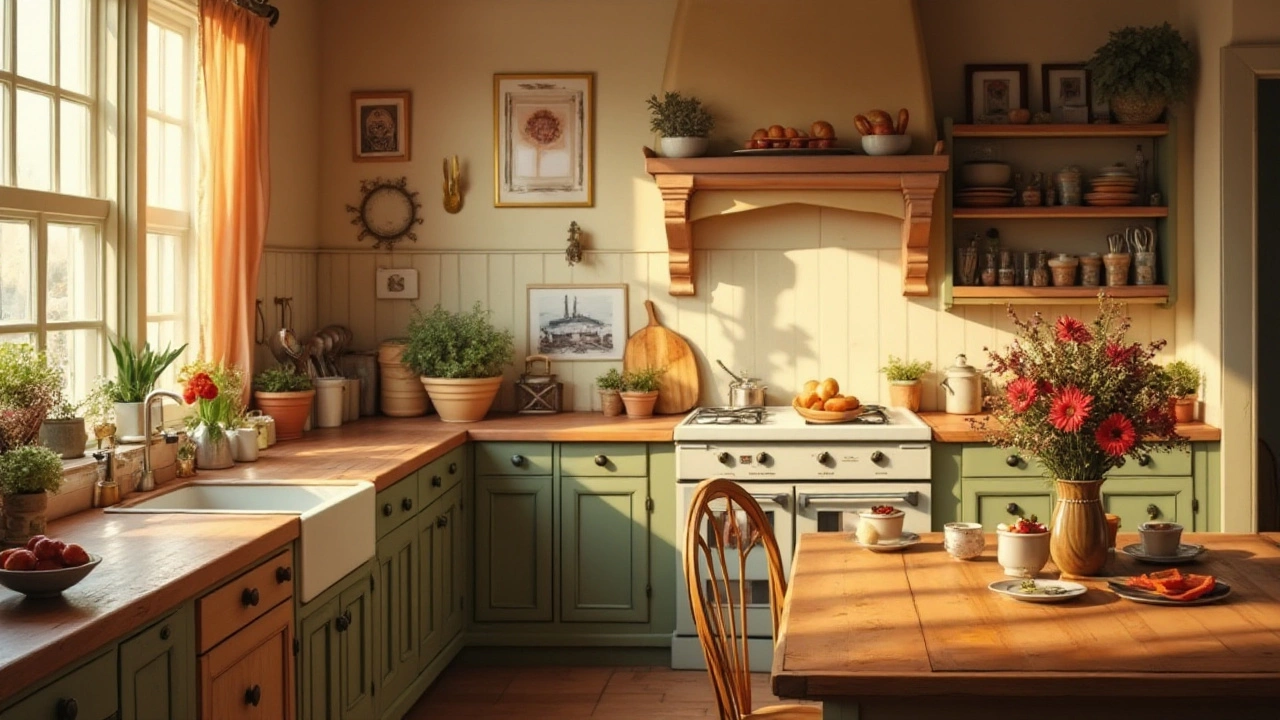The choice of color in a kitchen is more than mere aesthetics; it's a powerful force that shapes how the space feels and functions. Colors can make your kitchen look spacious or intimate, lively or tranquil, modern or classic. Selecting the right shade is a crucial decision whether you're redecorating or starting from scratch.
Beyond personal preference, various factors such as lighting, kitchen size, and even your cooking habits can influence the best color choice. While some may lean towards neutral tones for their timeless appeal, others might be drawn to contemporary hues that inject energy and personality.
In this article, you'll discover insights into how color affects mood and perception, trends that are making waves in kitchen design, and practical tips to guide you toward selecting a color that enhances your culinary haven.
- Understanding Color Psychology
- Timeless Kitchen Colors
- Popular Trends in Kitchen Design
- Bright and Bold Color Choices
- Warm vs Cool Tones
- Practical Tips for Choosing Colors
Understanding Color Psychology
Delving into the nuanced world of color psychology can greatly inform your kitchen design choices. Colors have profound effects on our emotions and our perceptions, influencing how we engage with different spaces. For instance, warm colors such as reds and oranges are known to stimulate appetite and conversation, making them ideal for spaces devoted to dining and cooking. Their energetic nature can transform a gathering in the kitchen into a lively and inviting experience, perfect for family meals and social gatherings. On the other hand, cool colors, like blues and greens, provide a calming and relaxing atmosphere, which can help create a soothing environment, ideal for someone who spends long hours cooking or baking.
Interestingly, different cultures also attach various meanings to specific colors, which can add layers to your kitchen's design. For example, in many Asian cultures, red is associated with luck and prosperity, making it a popular choice for kitchen spaces. This cultural significance can add personal and distinctive touches to your kitchen, making it not just a place for cooking, but a space layered with meaning. Conversely, green is often related to health and freshness, aligning with aspirations of well-being and vitality in your culinary space.
The Science of Color Perception
Scientific studies have shed light on why we react to colors the way we do. The cones in the human eye determine color sensitivity, and this physiological process influences why certain colors evoke strong responses. Researchers have found that yellow, a bright and cheerful color, can enhance concentration and attention. This makes it a potentially excellent choice for busy kitchens where multitasking is often required. As you cook up a storm, a yellow backdrop might just keep your mind and body agile.
A famed quote by interior designer Mark D. Sikes reads:
"Your home should tell the story of who you are, and be a collection of what you love."This sentiment is particularly true for kitchens, where the color scheme can directly reflect and impact your personality and mood. The tones you choose should resonate with personal experiences, imbue your space with an aura that makes every meal preparation session fulfilling, and invite every visitor into a snippet of your life’s tapestry.
The varying shades you incorporate into your kitchen's palette also come with functional and pragmatic considerations. Lighter shades tend to make spaces appear larger and more open, which is vital for smaller kitchen areas. A touch of white or cream, for example, might be the strategic move to elevate a cramped kitchen into a more expansive realm. Incorporating these psychological insights as well as practical design solutions could lead to a truly transformative kitchen design.
Timeless Kitchen Colors
When it comes to creating a kitchen design that will last decades without looking dated, selecting timeless colors is key. These colors transcend fleeting trends, offering an enduring appeal that can adapt to changing tastes and styles. One of the most quintessential timeless colors is white. Known for its ability to make spaces feel larger and cleaner, white reflects light beautifully, enhancing the natural brightness of any kitchen color ideas. It serves as a perfect backdrop for colorful accents or simple, elegant designs.
Another classic color is gray, which has gained popularity for its sophisticated and versatile nature. Gray provides a neutral base that complements a wide range of color palettes, from vibrant hues to soft pastels. This flexibility makes it ideal for homeowners seeking a balanced and harmonious look. Gray kitchens can exude warmth and charm when paired with wooden elements or maintain a sleek and modern feel when matched with stainless steel appliances.
For those seeking a more earthy vibe, consider incorporating shades of beige or taupe. These colors bring warmth and coziness to a kitchen space, harmonizing beautifully with both rustic and contemporary interiors. A beige kitchen can evoke a sense of tranquility and timelessness while providing a neutral tone that allows accent colors to stand out.
"Homeowners who opt for timeless colors like white, gray, and beige find themselves with a flexible canvas that can evolve with their changing style preferences," notes design expert Mary Smith.This quote highlights the adaptability of timeless colors, a feature cherished by many who desire longevity and versatility in their home design.
Beyond these popular choices, navy blue is also gaining recognition as a timeless color. Its rich depth introduces an elegant and bold look without overpowering the senses. Navy can ground a kitchen while adding a touch of luxury and classic appeal. Paired with gold or brass accents, navy blue becomes a statement of understated opulence, suitable for those who appreciate a more refined style.
For a gentler alternative, consider mint green or soft sage. These hues inject a subtle, refreshing charm into kitchens, invoking the calming presence of nature. Mint green is particularly effective in adding a vintage twist to modern kitchens, making it a smart choice for those yearning for a blend of old and new.
While trends may come and go, embracing colors with time-tested allure ensures that your kitchen will remain a cherished and functional space. As you explore your options, remember to consider your personal style and the way you use your kitchen. Classic doesn't mean boring; it means laying a strong foundation for design success, making room for personal touches and future innovations.
Popular Trends in Kitchen Design
Kitchen design trends have evolved considerably over the years, providing homeowners with a host of exciting options to choose from. One of the most notable shifts in recent times has been towards neutral color palettes, which offer a clean and timeless look. Soft whites, creams, and subtle grays blend seamlessly with natural textures such as wood and stone, creating a harmonious and inviting atmosphere.
Another popular trend is the use of bold accent colors. These can be used to add personality to the kitchen without overwhelming the space. For instance, a kitchen dominated by white or gray hues may suddenly transform with the addition of a bold red or emerald green island. These vibrant colors can add intrigue and a playful element to your kitchen design.
Technology has increasingly played a role in shaping kitchen aesthetics and function. Smart appliances and fixtures not only enhance convenience but are often now available in an array of colors and finishes. Matte black and stainless steel finishes, in particular, have taken center stage, paired with high-contrast colors like sunny yellows or deep blues to create a modern and innovative feel.
Mixing Materials
An interesting trend in kitchen design is the mixing of materials to create dynamic visual textures. Kitchen designers are seeing more demand for juxtaposing polished marble with weathered wood or sleek metals with rough stone. This eclectic approach breathes new life into traditional spaces, offering both contrast and cohesion.
"A well-curated color scheme that allows for mixing materials enhances the character of any kitchen," says Amanda Campbell, a renowned interior designer.
Eco-Conscious Designs
As sustainability becomes a priority for many, eco-friendly materials and sustainable design practices have become increasingly popular in kitchen renovations. Using recycled or natural materials not only contributes to an environmentally friendly lifestyle but often results in unique, handcrafted style elements within the kitchen.
| Trend | Popularity |
|---|---|
| Neutral Color Schemes | High |
| Bold Accent Colors | Moderate |
| Mixing Materials | Increasing |
| Eco-Conscious Designs | Growing |
Ultimately, these kitchen design trends reflect a broader desire for spaces that are not only visually satisfying but also functional and supportive of a sustainable lifestyle. Whether you choose to incorporate just one or all these trends, the key is to create a kitchen that feels like an extension of your personal style and meets the demands of daily life.

Bright and Bold Color Choices
Adding bright and bold colors in your kitchen can transform it from a basic cooking area to a vibrant heart of the home. These striking hues can infuse energy and life into the space, making it not only functional but also a place where creativity flourishes. Bright colors like fiery reds, sunny yellows, or deep blues can be excellent choices if you're looking to break away from the monotony of neutral palettes. They're known to stimulate conversation and appetite, which can be quite beneficial in creating a welcoming atmosphere for both family meals and social gatherings.
Red, often associated with increased appetite, is a popular choice for kitchens. Its intensity must be balanced; otherwise, it can be overwhelming. Combining red with white or wood tones can create a striking yet harmonious look. On the other hand, yellow is a color that evokes happiness and warmth. It's particularly effective in kitchens with limited natural light because it creates an illusion of a sunnier environment. When paired with cool gray or pristine white cabinetry, it achieves a fresh, modern look.
"Yellow kitchens can bring cheerfulness and a sense of warmth to a home, matching any traditional or contemporary style," suggests Lisa Smith, a renowned interior designer known for her expertise in color therapy.
Blue is another fantastic choice but should be applied carefully. It's a color that brings calmness and stability, engaging creativity and sparking innovation in cooking. For those who adore nautical themes, pairing bold blue with white and brass or copper accents can be visually stunning. Deep shades like navy can add a sophisticated touch without overpowering the space, especially in larger kitchens. It's crucial to balance blue with warm elements or cheerful accent pieces to avoid creating a cold ambiance.
Before diving into bold hues, consider experimenting on smaller accents first, such as a feature wall, splashback, or cabinetry. If painting an entire kitchen feels daunting, these elements can serve as testing grounds for your choice. Investing in sample pots can also be a wise decision; painting swatches on your walls can help visualize how light changes affect these colors throughout the day. Popular trends often feature bright kitchen colors in appliances or decor, offering a less permanent but equally impactful way to introduce boldness into your space. The key is finding the balance that reflects your personality and lifestyle while maintaining functionality.
Warm vs Cool Tones
Choosing between warm and cool tones for your kitchen is a matter that leans heavily on personal taste, but also deserves consideration for its impact on mood and perception. Warm tones, ranging from rich reds and sunny yellows to earthy browns, tend to evoke a sense of coziness and vitality. They are often used to create welcoming spaces that draw people in and encourage social interaction. Kitchens bathed in these hues emit a natural glow that can make even the most modest dish feel gourmet. By contrast, cool tones, such as blues, greens, and sleek grays, bring an air of calm and sophistication to a kitchen. These colors can help keep a space feeling fresh and clean, ideal for those who desire a serene environment. A well-curated cool palette can add a touch of modern elegance without compromising on warmth if balanced carefully with other elements like wood or metallic finishes.
Warm tones can make small spaces feel snug and inviting, which might be beneficial in larger kitchens where you want to create intimate dining areas or breakfast nooks. Meanwhile, cool tones can visually widen a space, making them ideal for smaller kitchens where every inch counts. A recent survey by paint specialists revealed that 65% of homeowners who chose cool tones did so to create an illusion of a bigger kitchen. It's also fascinating that many chefs prefer warmer hues, as they are said to stimulate appetite and creativity.
"The choice of kitchen color is an extension of one's culinary creativity," says renowned interior designer Sarah Richardson. "Warm tones inspire comfort and energy, while cool tones bring clarity and order."Integrating both temperature tones can lead to a dynamic and functional design, enhancing both aesthetic appeal and practical usability.
To successfully balance these tones, consider the fixed aspects of your kitchen, like cabinetry, countertops, and flooring. Warm-toned wood can pair beautifully with cooler walls, providing a rich contrast that is both soothing and stimulating. A backsplash in a subtle aqua or seafoam can introduce a cool element without overshadowing deeper wood cabinetry. If you're inclined towards a cool-toned kitchen with sleek gray cabinets, consider introducing warmth through accents like brass hardware or a terracotta vase. Sometimes, even the smallest pop of a contrasting hue can tie a room together, making the space feel both cohesive and inviting.
| Color Tone | Effect |
|---|---|
| Warm Tones | Cozy, Inviting, Stimulating |
| Cool Tones | Calm, Spacious, Modern |
While these guidelines can help frame your decisions, remember that the best choice often comes from blending what feels right with the practical functionality needed in a kitchen. It's all about creating a space that not only invites you in but also serves as the heart of your home, nurturing gatherings and quiet family dinners alike. Personal touches, informed decisions, and a willingness to experiment are the keys to achieving a kitchen design that sings with your personality and lifestyle.
Practical Tips for Choosing Colors
Embarking on the journey to select the ideal kitchen color ideas can feel like a daunting task, but with some strategic thinking, it can be an exciting adventure. One key aspect to consider is the size and layout of your kitchen. Smaller kitchens often benefit from lighter shades that open up the space, making it appear more expansive. On the flip side, if you boast a larger kitchen, you might want to play with deeper tones to create a cozy, inviting atmosphere. Consider the natural light that your kitchen receives. North-facing rooms might need warmer hues to counteract cooler light, while sunlight-drenched spaces can handle cooler or bolder colors without losing warmth.
Another important factor is to think about the cabinetry and appliances. A harmonious balance between these elements and your chosen color can lead to a more pleasing aesthetic. If your kitchen is outfitted with stainless steel appliances, you might favor pairing them with cooler tones or even bright, cheerful colors for that modern chic vibe. However, if wooden surfaces dominate, warmer tones might produce a seamless and natural flowing ambiance. Don't forget to test your color choices before committing fully. Painting small sections can give you a real feel for how a color acts under different lighting conditions and at various times of day, helping you dodge potential color mishaps in your kitchen design.
Considering emotional responses to color is another insightful approach. It's widely accepted that certain colors evoke specific feelings; reds and yellows are known to stimulate appetite and conversation, while greens and blues are thought to promote relaxation and creativity. This extends beyond aesthetics, supporting a functional and enjoyable cooking environment. As famed designer Kelly Wearstler once stated,
"Color is the heirloom of design, inviting moods and experiences into a home."Use this window into color psychology to craft a kitchen space that feeds both body and soul.
Lastly, let's discuss trends. Though jumping on the trend bandwagon can be tempting, remember the importance of timelessness. Trends can help inspire and guide decisions but seek those that provide lasting value. Combining trendy elements with classic hues can give your kitchen a fresh yet enduring appeal. For instance, while vibrant color bursts can be on-trend, they are well complemented by neutral bases that ensure longevity. By following such steps and tapping into a blend of popular trends and personal tastes, your next kitchen color trends project will surely be a success.
If you're still hesitant about taking the plunge, painting an accent wall or incorporating colorful accessories might be great alternatives to test the waters. Keep in mind, the ultimate goal is to transform your kitchen into a lively part of your home that reflects your personality and accommodates your functional needs. Consider investing in color consultation services if you're facing a considerable renovation or simply wish for a professional opinion. Their insights and expertise can be invaluable in achieving a cohesive and stylish look that you'll cherish for years to come.


